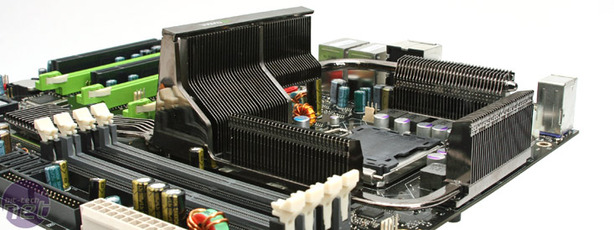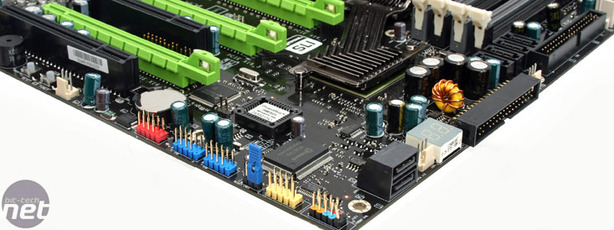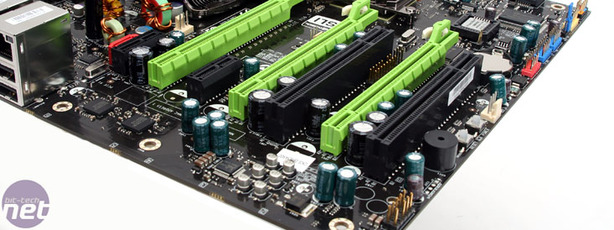First Look: Nvidia nForce 790i Ultra SLI
March 19, 2008 | 08:16

Board Layout
For those familiar with the nForce 780i SLI, the board style mirrors this very closely, but there are a few key changes that have improved the layout quite considerably. Obviously the four DDR2 slots are now DDR3 – if you’re running above 1,600MHz though the two black slots need to be specifically used.This limits the use of the board to just a pair of DIMMs when you want to really crank it up (which is the whole point of the nForce 790i), so it seriously limits what you can currently do with it. If you thought just 2GB of performance DDR3 isn’t enough for you, 4GB (2x2GB) kits are currently more than twice the price – they’re also limited to 1,600MHz and don’t include EPP 2.0.
Obviously, it is worth noting that EPP 2.0 is very new and more memory will be available in time, but if you’re an early adopter this might be quite a sticking point, especially since 4GB of performance DDR2 is less than £100. However, I suppose that 3DMark doesn't take that much memory anyway...
Since the NF200 chip is integrated and no longer takes up board space, there is an extra PCI-Express x1 slot and a SATA port in its place.
 The extra peripheral port is very welcome and provides access for something like a sound card when you're using 3-way SLI, as it covers up every other expansion slot.
The extra peripheral port is very welcome and provides access for something like a sound card when you're using 3-way SLI, as it covers up every other expansion slot.However, why bother with the SATA by here? Just use the port for an extra eSATA instead – it’s in such an awkward place it can't easily be used and you can’t string it together with the other six SATA ports as well for an expanded RAID array for example.
Pin-out placements have been improved compared to the XFX nForce 780i SLI – all these are placed down along the base now and the two digit LED readout is now lined up against the inside edge so it’s easier to see when multiple, long PCI-Express cards are used. The ATX, IDE and SATA sockets are easy to get to, but the 12V CPU power socket is awkwardly wedged between the rear I/O and heatpipes.

The cooling has also been “improved” – while there are more heatpipes with larger fins that surround the CPU to improve cooling, they are over 30mm high in some parts and the north bridge heatsink is over 60mm high. This could provide a serious issue for CPU cooler compatibility and it also means replacing the heatpipe system is very difficult for those wanting to use their own coolers.
What certainly is better is the chipset cooling fan is back facing the right way again and points towards the CPU. With the nForce 780i SLI reference design the chipset fan blows the hot air onto the back of the graphics card (actually right onto the back of the GPU core) which doesn't help much at all when the graphics card is typically the warmest thing in an enthusiast’s system. At least now the hot air is blown in the direction of the CPU and sucked out the back of the case.

EVGA and Innovatek are offering watercooling blocks to replace them and there are motherboard holes available. These holes are currently used for proper sprung screws in the current included heatpipe system to provide a higher pressure contact that should mean better heat transfer.
The CPU socket gets a very similar six phase power system that was used with the nForce 780i SLI, however it has a set of improved Chokes. What hasn’t changed is the single power phase for the north bridge, memory and south bridge, which is compared to two or even three phases used elsewhere on performance motherboards. For the cost, we’d have argued this board should match those.

Only a few solid aluminium capped capacitors are used in key places like around the CPU socket and interestingly for the sound codec too – these are specifically super-low ESR surface mount versions. The rest of the capacitors are the standard electrolytic type but feature high quality Japanese Rubycon and KZJ which we are familiar with, and another branded Samxon.

MSI MPG Velox 100R Chassis Review
October 14 2021 | 15:04








Want to comment? Please log in.